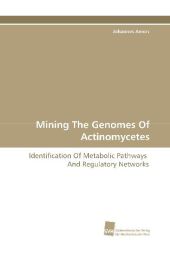 Neuerscheinungen 2010Stand: 2020-01-07 |
Schnellsuche
ISBN/Stichwort/Autor
|
Herderstraße 10
10625 Berlin
Tel.: 030 315 714 16
Fax 030 315 714 14
info@buchspektrum.de |

Johannes Amon
Mining The Genomes Of Actinomycetes
Identification Of Metabolic Pathways And Regulatory Networks
2010. 140 S. 220 mm
Verlag/Jahr: SÜDWESTDEUTSCHER VERLAG FÜR HOCHSCHULSCHRIFTEN 2010
ISBN: 3-8381-1740-9 (3838117409)
Neue ISBN: 978-3-8381-1740-9 (9783838117409)
Preis und Lieferzeit: Bitte klicken
Based on available genome sequences and homology searches with already described systems of close relatives, the up to now mostly unknown repertoire of nitrogen metabolism-related genes in the genus Mycobacterium was discovered and putative pathways and regulatory networks have been constructed and compared. In respect to carbohydrate metabolism, the repertoire of carbohydrate uptake systems in the genus Mycobacterium was studied and predictions about the comparative growth potential of M. smegmatis and Mycobacterium tuberculosis on various carbon sources were provided. In a similar approach, the genome of the industrial relevant probiotic Bifidobacterium longum has been examined for carbohydrate uptake systems. Furthermore, the proteolytic potential of various Corynebacterium species based on all available genome sequences was compared and resulted in a more complete view on the housekeeping protease systems as well as on proteases putatively involved in pathogenicity and virulence of Corynebacterium diphtheriae.
Dr. Johannes Amon, born 1978 in Bamberg, Germany, is a laureateof the Carl Friedrich von Martius environmental award. He studiedbiology at the Friedrich-Alexander University Erlangen-Nürnberg.In his thesis, he focussed on prokaryotic genomics andtranscriptional regulation inside the phylum of Actinobacteria.


